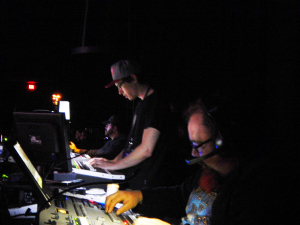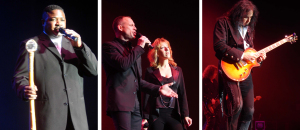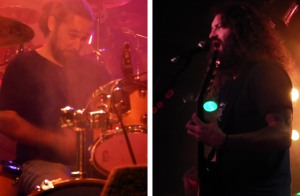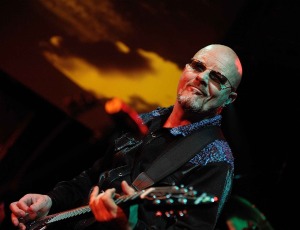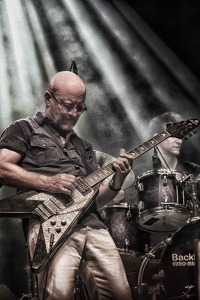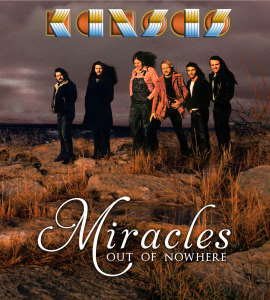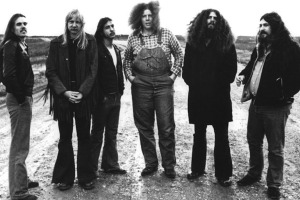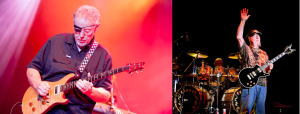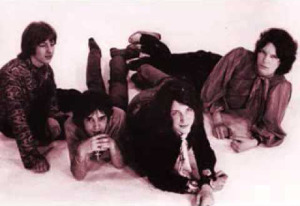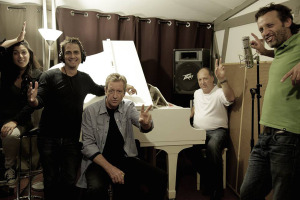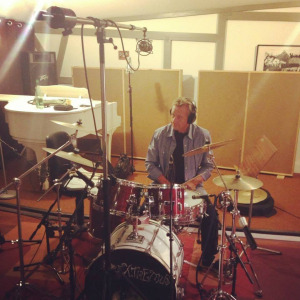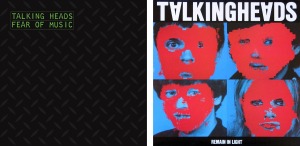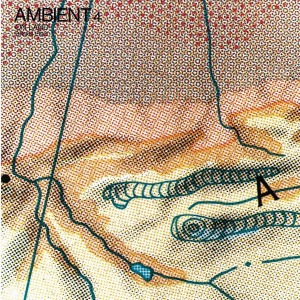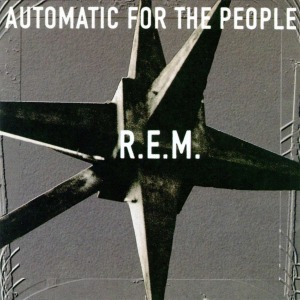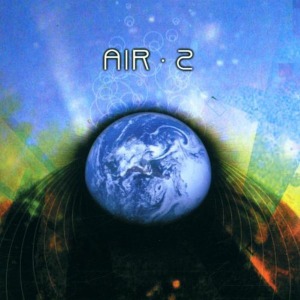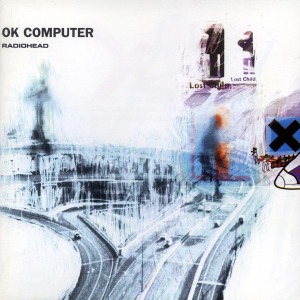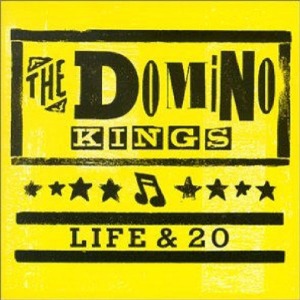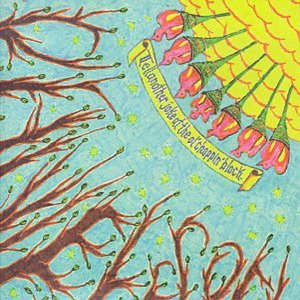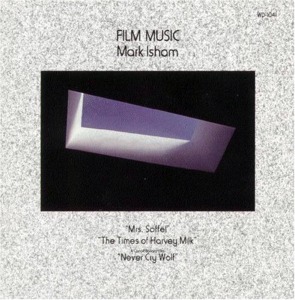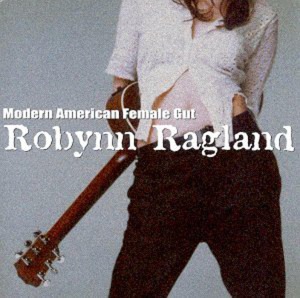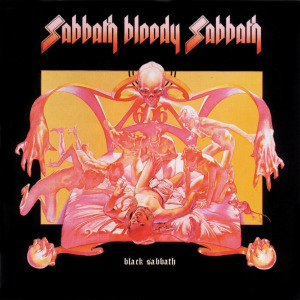(January 30, 2016; READY ROOM, Saint Louis MO)
I gotta admit, I wasn’t real sure what to expect out of Epica… I just knew that I really wanted to see legendary Portuguese Goth metallers, Moonspell, again. Serious doubts entered my mind about the whole night when it seemed as though this was going to be another one of those sparsely attended Saint Louis shows; with about 30 minutes to go before start time, the room was less than half full. However, to my utter surprise (and delight), each check over my shoulder saw the head count rise to the point that, by the time Starkill took the stage, the floor was packed. And, what a great evening of rock and roll was on hand for one and all, beginning with…

Chicago progressive speed merchants, Starkill. The band’s prime mover, Parker Jameson, showed himself adept at both dirty and clean vocal styles, as well as impressive lead and solo guitar… he was even responsible for the prerecorded keyboard parts featured throughout the six-song set. The show highlighted Starkill’s most recent release, VIRUS OF THE MIND with three songs, including their opening salvo, “Be Dead or Die.” Odd title aside, the tune featured an intense orchestral intro from Jameson and a massive drum sound. Surprisingly, the strongest material has yet to be officially released, “Burn Your World” and “Cloudless,” from an upcoming third album (after two albums with Century Media, the band is self-releasing this one with fan funding from Indiegogo); maybe the strength of these new songs comes from the fact that guitarist Tony Keathley and bassist Shaun Andruchuk are now firmly ensconced in the fold (VIRUS OF THE MIND was pretty much finished when they were brought on board). Andruchuk is an absolute beast, prowling the stage and giving the guitars and vocals ample underpinning alongside the borderline maniacal drum-bashing of Spencer Weidner. As impressive as the rhythm section is, this group’s strength lies in the vocals (with Keathley supporting Jameson with clean counter-vocals and, in some instances, nice harmonies) and the twin lead work from the fleet-fingered guitarists, put to particularly good use on “Virus of the Mind.” What could have been a fairly unextraordinary set of Death Metal was continually lifted to unexpected heights by the clean vocals of both Parker and Tony, Spencer’s percussive expertise and the use of Parker’s keyboard and orchestral embellishments. These guys can only get better.

Moonspell have always tended toward the dark, Gothic edges of metal. More recently, they have gone full-tilt into the Gothic sound and lyrical imagery of such bands as the Damned, True Sounds of Liberty (TSOL), Danzig (both the metal band and their punk Misfit leader) and the lugubrious funeral dirges of Type-O Negative. The band were ushered to the stage with the atmospheric, near-operatic (as in THE PHAMTOM OF… ) “La Baphomette,” the final track from their latest record, EXTINCT; as vocalist Fernando Ribeiro took to the boards, the recorded intro faded, replaced by the ponderous beats of Mike Gaspar’s drums and the massive sound of Pedro Paixao’s pipe organ for the haunting “Breathe (Until We Are No More),” the opening cut from the same album. Guitarist Ricardo Amorim and bassist Aires Pereira initially seemed to be completely buried in the mix with the nearly overwhelming volume of the pipe organ. However, the problem was soon rectified and, to paraphrase the dearly departed Lemmy, everything was louder than everything else, with Pereira’s bass adding to the rhythmic din laid down by Gaspar and Amorim’s tasty licks leading the way on Moonspell’s musical moonlight drive through the cemetery. The band seemed to kick into high gear with the title track from EXTINCT, particularly Ricardo, who delivered the first of many killer solos; they really hit their stride, however, on older tunes like the slow grind of “Awake” (from 1998’s IRRELIGIOUS album) and a pair of late set favorites from their 1995 debut, WOLFHEART (the eerie fist-pumper “Vampiria” and “Alma Mater,” which featured a very nice old-school rock solo from Amorim). Ribeiro hung around the lower registers, occasionally approximating the bone-rattling baritone of the sorely missed Peter Steele or, alternately, delivering the gutteral death-rattle of the genre – moving effortlessly between the two at the drop of a coffin lid… plus, his accent kinda reminded me of Bela Lugosi. As good as Starkill was, this was definitely the highlight of the evening for me; could the headliner hope to match or exceed what Moonspell brought to the stage?

Kicking their set off with a couple of tracks from their latest release (THE QUANTUM ENIGMA from 2014), from the get-go, it was obvious that the name of these Nederlanders’ game was speed and precision; guitarists Isaac Delahaye (the lone Belgian in the group) and Mark Jansen proved to be fleet-of-finger, while bassist Rob van der Loo and drummer Arien van Weesenbeek matched them with a wicked ferocity and keyboardist Coen Janssen added a touch of the symphonic. Of course, above all was the unbelievable mezzo-soprano voice of the lovely Simone Simons. “The Second Stone” and “The Essence of Silence” were formidable blasts of Wagnerian bombast, with mystical/metaphysical lyrics, alternating between Simons’ operatic vocals and Jansen’s harsh, throaty growl. Amidst a flurry of hair-whipping, it was obvious – much like Moonspell before them – that the band (and an appreciative audience) really started to have fun with the introduction of some fan-favorite older material, beginning with “Sensorium,” from the group’s debut release, THE PHANTOM AGONY. With “Martyr of the Free World,” Coen Janssen emerged from the shadows (and fog) engulfing stage-right’s back corner with a unique bowed keyboard, soloing and mugging for the crowd (and I still couldn’t get a decent shot of the third original member of the group, along with Simone and band founder, Mark Jansen); toward the end of the song, after basking in the much-deserved accolades of the packed room, Janssen returned to his omni-directional keyboard as Delahaye killed a lightning-quick solo.

As you may well guess, any band with the type of near-virtuosity that each member possesses is going to solo and solo often. On “Cry For the Moon,” it was Weesenbeek’s turn, as the hard-pounding drummer delivered a powerful, tastefully short exhibit of his abilities. The song itself, another track from THE PHANTOM AGONY, built from a basic, martial rhythm to an anthemic slow-simmer to a full-blown operatic tour de force, with a Teutonic-sounding choir (via a sample or backing tape) adding a new dimension to the already forceful vocals of Simone Simons. Though Epica has been called a “Gothic Metal” band, it really isn’t until “Storm the Sorrow” that I caught anything (other than certain lyrical content) remotely Gothic in their music, with the heavy, near-industrial riffage and doom-laden piano flourishes; the fact that the upbeat vocal performance belies the nightmarish lyrics only adds to the Goth feel… a real highlight. The brutally dark vibe continued, with Mark delivering more of his intense, harsh vocals throughout the next few songs,” including “The Obsessive Devotion” and, from THE QUANTUM ENIGMA, “Victims of Contengiency.” This darker sound also gave van der Loo a chance to shine with more complex bass lines, rather than sticking fairly close to the rhythmic patterns laid down by the drums and guitars; this complexity was best displayed on the title track to 2009’s DESIGN YOUR UNIVERSE, the closing number of the main set, which also featured some very nice multi-textured keyboard work from Coen.

Unsated, the appreciative crowd refused to leave without hearing more; Epica was more than willing to oblige. With Janssen exhorting the rabid fans, he was soon joined by Weesenbeek, Delahaye and van der Loo, teasing the encore before Simons and Jansen returned for a stirring “Sancta Terra.” The band wasn’t messing around with a “one-and-done” trip back to the stage; they followed that tune with a great version of one of the stronger songs from THE QUANTUM ENIGMA, “Unchain Utopia.” If that wasn’t enough, refusing to go gentle into that good night, the sextet finished with a thundering version of the bombastic, anthemic epic, “Consign To Oblivion.” Like last November’s Amaranthe show at Pop’s, Epica eschewed the use of any visible, onstage amplification or monitors; however, where the sound was, at best, spotty for that earlier show, here, it was near perfect. The lighting, also, was some of the best I’ve seen in recent memory. So, earlier in this review, I asked the question, “Could Epica hope to match or exceed what Moonspell brought to the stage?” The answer, my friends, is an unequivocal, “Yes!” A great night of metal, from top to bottom.


